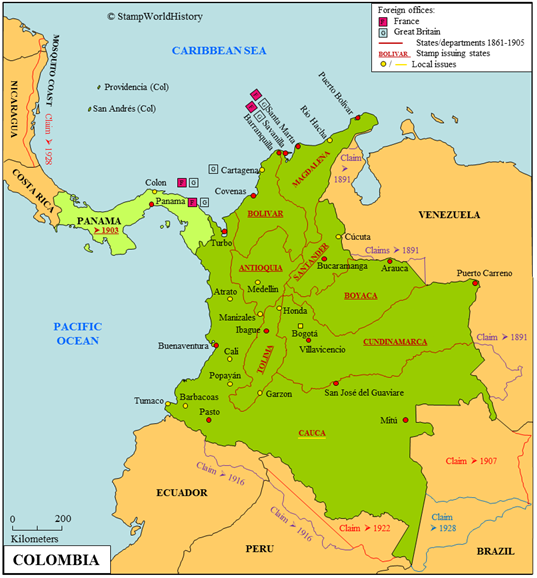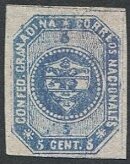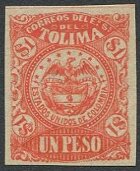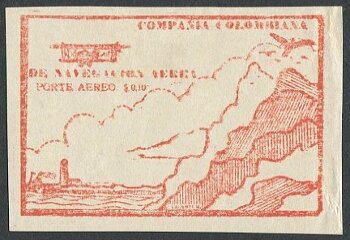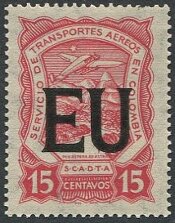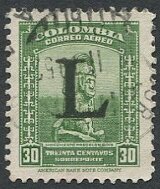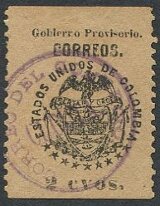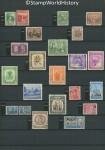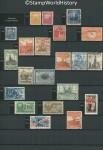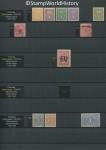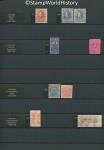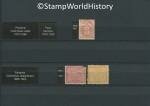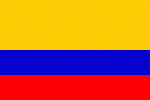
Colombia
Quick reference
General issues: Granadine Confederation 1859-1861, United States of New Granada 1860-1861, United States of Colombia 1861-1886, Republic of Colombia 1886-Present
Country name on general issues: Confed. Granadina, Estados Unidos de Nueva Granada, Estados Unidos de Colombia, E.U. de Colombia, EE. UU. de Colombia, Colombia
Special issues:
- Colombian states:
- Antioquia: State 1868-1886, Department 1886-1906
- Local issues with departmental validity: Medellin 1889-1901
- Bolívar: State 1863-1886, Department 1886-1906
- Boyacá: Department 1886-1906
- Cundinamarca: State 1870-1886, Department 1886-1906
- Santander: State 1884-1886, Department 1886-1906
- Local issues with departmental validity: Cucuta 1904-1905
- Tolima: State 1870-1886, Department 1886-1906
- Antioquia: State 1868-1886, Department 1886-1906
- Departmental issues 1909
- Airline issues
- Compania Colombiana de Navegacion Aérea 1920
- Avianca 1950-1952
- Lansa 1950-1952
- SCADTA
- General issues 1920-1932
- Offices abroad 1923-1929: Argentina & Uruguay, Belgium, Bolivia, Brazil, Canada, Chili, Costa Rica, Cuba, Denmark, France, Germany, Great Britain, Italy, Netherlands, Panama, Peru, Spain, Sweden, Switzerland, United States, Venezuela
- General issues offices abroad 1929-1932
- Local issues:
- City post: Bogotá 1889-1903, Manizales 1909, Medellin 1903-1910
- Provincial post: Cauca/Atrato 1882-1883, Cauca/Choco 1879
- Local issues with national validity: Cauca/Popayán 1902, Cauca/Tumaco 1900, Cartagena 1899-1903, Cartagena 1904, Cartagena 1908, Medellin 1902, Santander/Cúcuta 1907
- Postmaster provisionals: Cauca/Barbacoas 1901-1904, Cauca/Cali 1876-1878, Cauca/Popayán 1878, Cauca/Tumaco 1901, Cauca/Tumaco 1912, Tolima/Garzon 1894, Tolima/Honda 1896, Magdalena/Rio Hacha 1902
- Insurgent issues: Cauca/Tumaco 1902, Santander/Cúcuta 1900
Related issues
- Panama
- Colombian state 1878-1886, Colombian department 1886-1903
- Local issues: Colon 1897-1899
Currency: 1 Peso = 100 Centavos
Population: 3 110 000 in 1900, 48 320 000 in 2013
Political history Colombia
Colonization and independence
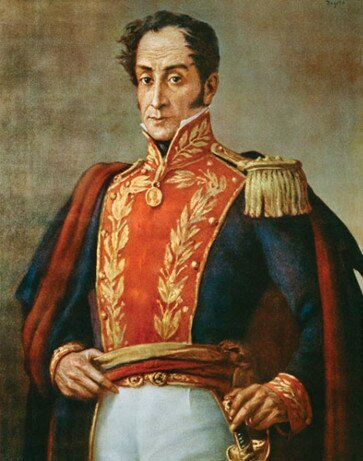
Simón Bolívar was probably the most notable figure in the independence wars in South America. Being the leading figure in achieving independence for Colombia and Venezuela Bolívar also played a decisive part in the wars of independence in Bolivia, Ecuador and Peru.
Colombia is located in South America. Before colonization, Colombia is home to a range of Amerindian civilizations of which, by the 15th century, the Chibcha are the most important. The Spanish first set foot on Colombian soil in 1500. As the Spanish set out to explore and conquer the country, most of modern day Colombia is under Spanish control by the late 1530’s. Initially part of the Viceroyalty of Peru, Colombia in 1717 becomes part of the Viceroyalty of New Granada that also comprises modern day Ecuador, Panama and Venezuela.
After Napoleon has conquered Spain, what will become independence movements are triggered all across the Spanish possessions in the Americas. In 1810, independence is declared in Cartagena, followed by other cities, and leading to the establishment of the Federated Provinces of New Granada in 1811. Independence at this stage is short lived as royalists loyal to Spain soon regain control of most of the country. In 1819, independence is once again declared by Simón Bolívar who is victorious in the 1819 battle of Boyacá and will gain full control of Colombia by 1822. Colombia is joined by Ecuador, Panama and Venezuela to form the republic of Colombia – also known as Gran Colombia. Conflicts about a federal versus a centralist form of government lead to the dissolution of Gran Colombia as Ecuador and Venezuela proclaim independence in 1830. The republic of Colombia is, in 1831, succeeded by the republic of New Granada, comprising modern day Colombia and Panama.
Federalism versus centralism
The conflict between federalists and centralists will continue in the Republic of New Granada. As political parties are formed in the late 1840’s – the first political parties to be formed in the Americas – the conflict evolves into a conflict between the liberals advocating federalism and the conservatives advocating centralism. In the 1850’s, federalist forces gain the upper hand. The departments of the republic of New Granada are grouped together to form states: Panama is the first in 1855, Antioquia follows in 1856, Santander in 1857 followed later in 1857 by Bolivar, Boyacá, Cauca, Cundinamarca and Magdalena. Tolima is formed in 1861, carved out of Cundinamarca. In 1858, these states form the Granadine Confederation – the states in the 1858 constitution being called ‘federal states’. Subsequent attempts to centralize power in the presidency of the Confederation lead to civil war. In 1860, the states of Cauca and Bolivar, led by Tomás Cipriano de Mosquera, secede to form the United States of New Granada. In 1861, de Mosquera is victorious and proclaims the United States of Colombia – a new constitution is drawn up in 1863 in which the states are called ‘sovereign states’. Conflicts will continue, and in the 1880’s the conservatives gain the upper hand leading, in 1886, to the establishment of the centralized republic of Colombia as we know it until today. The formerly sovereign states become departments of the centralized republic.
Establishing the borders
As the Republic of New Grenada was proclaimed in 1831, the borders had yet to be established. With Venezuela, most of the border was defined by ‘uti possidetis juris’ principle that states that borders between he newly formed states would be established along the lines of the borders in colonial times. Adjustments were made in 1891, thus establishing the current border. With Brazil, the border is established in two subsequent treaties in 1907 and 1928, Colombia ceding it’s claims to territories that de facto had, since the mid 19th century, been occupied by Brazil. A claim to the Mosquito Coast – added to the Viceroyalty of New Granada in 1803 – was dropped in 1928. Most complex was the establishment of the borders with Ecuador and Peru. The ‘uti possidetis juris’ principle did, in this case, not provide an easy solution. Eventually, a border treaty was signed with Ecuador in 1916 and with Peru in 1922, thus establishing the borders with these countries as we know them until today.
Conservatives versus liberals
The conservatives and liberals continue to dominate Colombian politics, often leading to tensions – at times escalating into civil war. From 1899, the conservative government is opposed by liberal insurgents in the 1000 Day War – a war ending largely in a status quo ante bellum. The weakened Colombia had to accept the secession of Panama in 1903 – a secession furthered by the United States to allow for the construction of the Panama Canal. The disputes again escalate into armed conflict between militias from the conservatives and the liberals in the period of what is called the ‘La Violencia'[1]‘The Violence’ – a period that lasted from 1946 until 1958 with a peak between 1948 and 1953. As an outcome of La Violencia in 1958, the conservatives and the liberals formed the National Front – agreeing to alternate the presidency every four years. This arrangement lasted until the late 1970’s early 1980’s. Since then, presidents have been elected from other political parties also, such as the current president Uribe who came to office in 2002.
Opposition from the left and the right – drug cartels
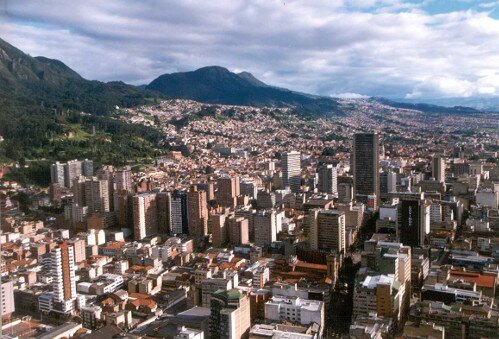
Colombia is a highly urbanized country with 60% of the population living in cities. The capital Bogotá is the largest city with 6,4 million inhabitants.
The domination of Colombian politics by the conservatives and the liberals, from the 1960’s, led to the formation of opposition movements, both to the extreme left and right of the political spectrum. To the right paramilitary militias were formed, to the left the most notable movement is formed by the Fuerzas Armadas Revolucionarias de Colombia or FARC. These movements were funded, in part, by the cultivation of and trade in drugs, leading to the establishment of large, powerful drug cartels – the largest being run from Medellin by Pablo Escobar. Each of these groups would at times control parts of Colombia. With assistance from the United States, the drug cartels were curtailed in the 1990’s. The conflicts between right wing and left wing groups that had escalated in the 1990’s was subsequently curtailed as right wing militias were demobilized in the 2000’s, while in the same period, the position of the FARC was diminished by a successful campaign of the Colombian army. Recently, a peace agreement has been signed with the FARC of which the details are currently being worked out.
Economy and demographics
Economically, Colombia has known a boom in the first part of the 20th century through the production of coffee which at some point contributed 90% to the countries exports. Since then, the economy has been diversified, from the 1990’s, stimulated by the liberal economic policy from the government. Natural resources – coal and oil – have replaced coffee as the post important export products. Colombia is one of the worlds largest exporter of emeralds. Despite the political turmoil in the country, the economy has shown steady development. Colombia is currently qualified as an upper middle income economy.
The population of Colombia consists of 85% Mestizos and whites. About 10% are Afro Colombians – descendants of the slaves that were brought to Colombia to man the plantations. The Amerindian – indigenous – population constitutes only 3.4 % of the population. The population is concentrated in the western half of the country – the Andes and coastal regions. The eastern half is home to only 3% of the population. Colombia is a highly urbanized country with 60% of the population living in the cities.
Postal history Colombia
General issues
The first stamps issued in Colombia are issued in 1859 in name of the Granadine Confederation – showing the coat of arms. During the 1860-1861 civil war, Colombia was divided. Stamps were also issued by the United States of New Granada – the states of Bolivar and Cauca – inscribed ‘Estados Unidos de Nueva Granada’. Both the issues of the Granadine Confederation, and the United States of New Granada, were, from 1862, superseded by the issues from the United States of Colombia. The republic of Colombia has issued stamps from 1886. Until about 1886, pen cancellations were more common than hand stamp cancels. Hand stamp cancels – especially when legible – are thus of higher value. Colombia has, until the present day, largely issued stamps with themes of national interest.
British offices abroad were operated in a number of cities, from 1865 to 1881 when Colombia joined the UPU, using the stamps of Great Britain. The Panama office was operated until 1884. French offices were operated in a number of cities from 1872 to 1874 using the stamps of France.
Declared value stamps
Colombia has issued a wide range of ‘back of the book’ stamps: special delivery stamps, registration stamps, late fee stamps and so on. An interesting category[2]Listed in the Michel catalog. are the ‘Cubiertas de valor declarado'[3]‘Covers of Declared Value’ . They were actually large stamps, or labels, used for franking and insuring letters containing money, checks or other valuable papers. They were issued on the national level from 1865 to 1905. The state of Tolima issued declared value stamps from 1879 to 1896. Issues from Cundinamarca and Santander seem to be disputed.
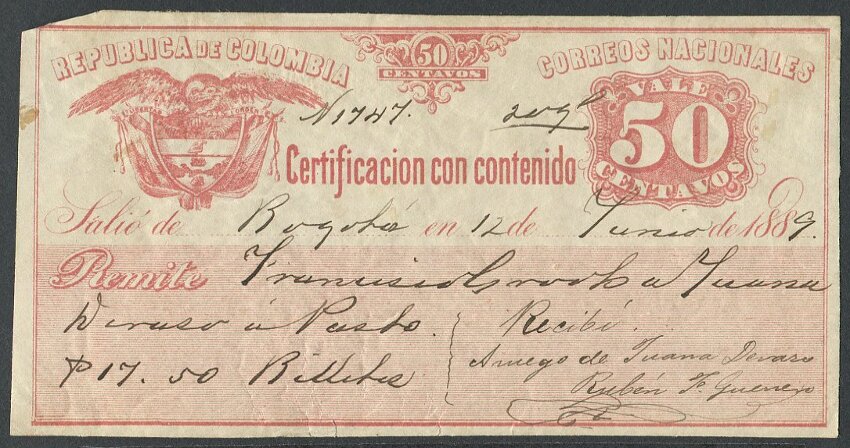
1887 – Declared value stamp. Please note that the scale is the same as that of the other stamps on this page
These declared value stamps were widely used in Colombia. The process was that a clerk at the post office would check the content of a letter, fill out the part of the stamp which indicated when the letter was to be sent and the part naming the sender, the addressee and value of the content. Initially, a wax seal would be used to seal the cover, later the declared value stamps were used for this purpose and thus affixed to the back of the covers. The recipient would sign the declared value stamp for the receipt of the content, the cover would be archived at the post office. I have not come across similar stamps issued by other countries.
Colombian states
As the Colombian States were formed, from 1855, these states were also given the right to issue stamps. Stamps that were valid for use within the state only and that were used concurrently with the general issues of Colombia. The first state to issue stamps was Bolívar from 1863. The other states followed suit from varying dates, with the exception of the states of Cauca and Magdalena that seem not to have had a departmental stamp issuing policy. The states turned into departments in 1886, but continued to issue stamps until, by decree in 1906, the departmental issues were withdrawn. Panama is to be counted as one of the Colombia states until 1903, although, the stamps issued by Panama in this period are generally listed with Panama rather than Colombia. The most common theme in the design of the stamps issued by the Colombian states is the coat of arms of the respective states. The exception, is Bolívar where the portrait of Simón Bolívar is the leading theme.
Although departmental issues were withdrawn in 1906, postal authorities remained in place on the departmental level. In 1909, stamps were issued to subsidize these departmental authorities in operating the postal services. Stamps previously issued on the national level – and one stamp previously issued by Tolima – were overprinted ‘Correos Dep(arta)mentales’ and supplied by the national postal authorities to the departmental authorities at a 50% discount to be used for departmental mail.
Airline issues
Airmail has played an important part in Colombian postal history. The first test flight by the American pilot Knox Martin took place in 1919 under the auspices of the government – a special stamp was issued to commemorate the event. The first air mail services were provided by private companies. In 1919, two commercial airlines were founded – these to be the first in the Americas and among the first in the world.
- Compania Colombiana de Navegaceon Aérea: The ‘Compania Colombiana de Navegaceon Aérea'[4]‘Colombian Air Navigation Company’ , known as CCNA, was one of the companies founded in 1919. The company was set up with French financial support and French staff. It gained a concession to provide air mail services from the government in 1919. Stamps were issued by the company in 1920. The stamps were issued to cover the air mail surcharge, which was in addition to the regular postal charges. The first set of stamps was originally designed as labels for inclusion in cigarette packs – these labels were overprinted with the company name. Only 100 sets were issued – which is reflected in the high catalog values for the set. Later issues were of a more simple local design. Services were provided between Baranquilla and Cartagena and later Santa Marta. Routes to Puerto Berrio – to connect to Bogotá – and Medellin were explored but not exploited. The company suffered a number of setbacks that resulted in the liquidation of the company in 1921.
-
SCADTA: The second commercial airline company to be founded in 1919 was the ‘Sociedad Colombo-Alemano de Transportes Aéreos’ or SCADTA also based in Baranquilla. SCADTA was founded with German financial support and German staff. SCADTA also gained a concession to provide air mail services in 1920 and issued stamps from 1920. As with its competitor, the stamps were issued to cover the air mail surcharge in addition to the regular postal charges. In the 1920’s SCADTA developed a much more extensive network with routes along the Caribbean and Pacific coast, inland to Bogotá and Cali, and with extensions to countries such as Ecuador, Panama and Venezuela. SCADTA also made its services available abroad. SCADTA stamps could be purchased at SCADTA agencies and Colombian consulates in a range of countries. To ensure that the stamps would be sold at the right exchange rates they were, from 1923 to 1928, overprinted with the initials of the countries in which they were sold – known as Consular Overprints. From 1929, the denomination was in the the gold peso and tied to the dollar. From then on stamps were issued for general use in the offices abroad. Also, for currency reasons, special stamps were issued for the routes to Ecuador from 1928 to 1931. In 1932, SCADTA gained a contract from the government to operate its routes as part of the Colombian postal services, and from then on air post stamps issued by the Colombian postal authorities were used. SCADTA through the years retained a largely German staff which, at the outbreak of WWII, came to be seen as a security risk. SCADTA was therefore, in 1940, forcibly merged with the state owned Servicio Aéreo Colombiano to form the national airline Avianca. The German staff was subsequently replaced.
-
Avianca & Lansa: In 1950 the domestic airmail services were contracted out to Lansa, ‘Limitada Nacional de Servicio Aereo’ – another commercial airline. In June 1950, the first stamps were issued for the services provided by Lansa inscribed ‘LANSA Sobre Porta’. These were issued to cover the surcharge of the airmail services. Regular air post stamps were issued in July 1950 – now previous Colombian air post issues overprinted ‘L’. The international air mail services were provided by Avianca, the national airline. For these services stamps were issued overprinted ‘A’. A second set of similar overprints appeared in 1951. Lansa in 1952 was merged with Avianca. From then on air post stamps without overprints were again issued. Avianca is in operation until the present day as the national air line of Colombia.
Local issues
Between 1876 and 1912 a range of local issues has appeared in Colombia. These issues present a true challenge to the collector. They are listed in different ways in each of the world wide catalogs, some listing more than others. Several of these issues are disputed and the insights of the catalogs change over time – for example, several issues listed in the 1947 edition of Scott are, in recent editions, no longer listed. I have tried to group the local issues together based on common elements in the context in which they were issued. In the quick reference section please find all local issues to be found in the worldwide catalogs – disputed or not. In this section, please find an evaluation of where the catalogs find common ground in their listings of the local issues.[5]The catalogs in this case include Michel, Scott and Yvert & Tellier. Stanley Gibbons has very limited coverage of the local issues.
- City post: Stamps issued for local postal services. The Bogotá 1889-1903 issues are listed across catalogs.
- Provincial post: The Colombian states were subdivided in provinces. In the state of Cauca, stamps have been issued for a provincial post operating from Atrato in the Choco province. None of these issues are listed across catalogs.
- Local issues with departmental validity: Stamps issued with authorization from the departmental postal authorities, valid for departmental mail. The Medellin 1889, 1890 and 1901 issues are listed across catalogs.
- Local issues with national validity: Stamps issued with authorization from the national postal authorities, valid for national mail. Cartagena issues between 1899 and 1903 and a Popayán issue from 1902 are listed across catalogs.
- Postmaster provisionals: In a number of cities postmaster provisionals have been issued. Stamps of a basic design that, as a common characteristic, have the inscription ‘No hay estampillas’ for ‘No stamps available’. Most have a face value inscribed, some require the post office fill out the value by hand. Several of these issues carry the name or initials of the postmaster. All of these issues are, in recent catalogs, listed or referred to as disputed as they are considered not to be postage stamps but receipt labels.
- Insurgent issues: Stamps issued under the authority of a provisional government. The 1900 issues of Cúcuta are listed across the catalogs.
Album pages
← Previous page: ChileNext page: Costa Rica →

